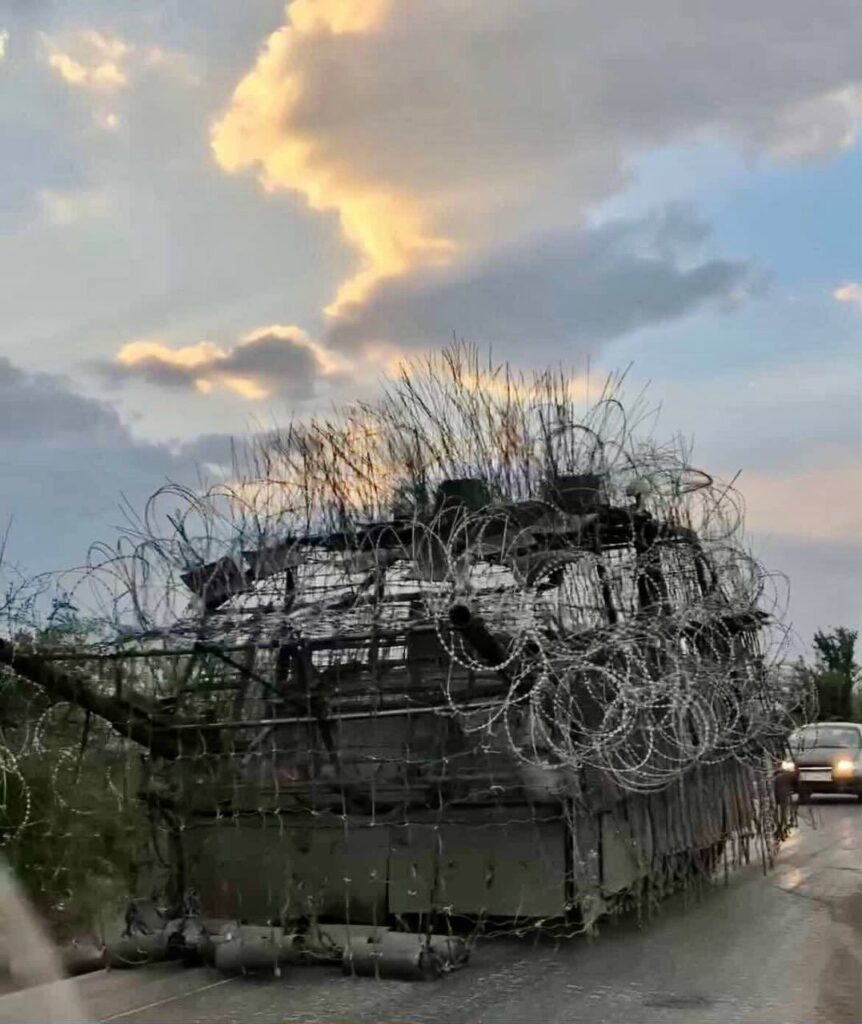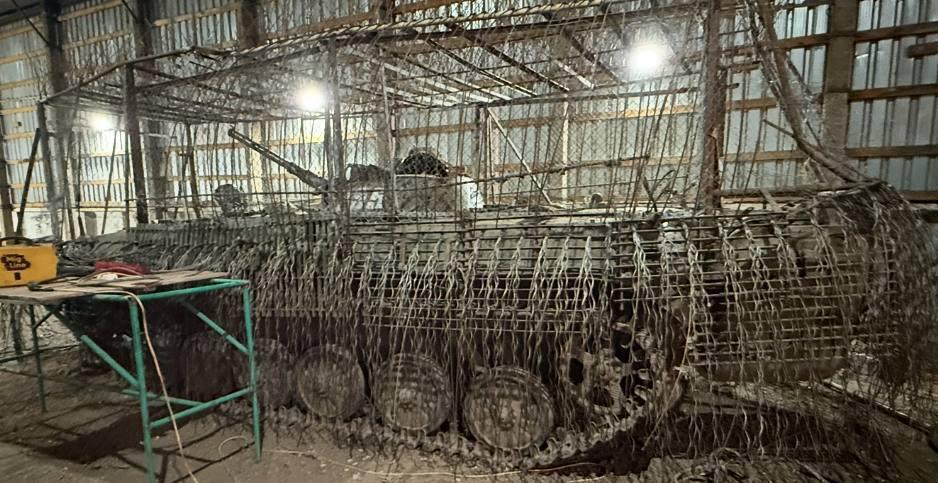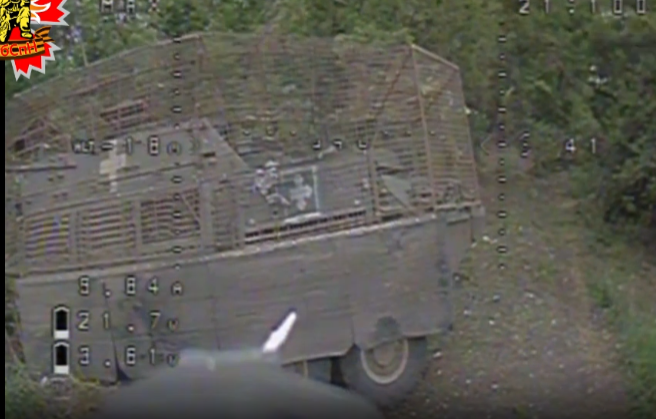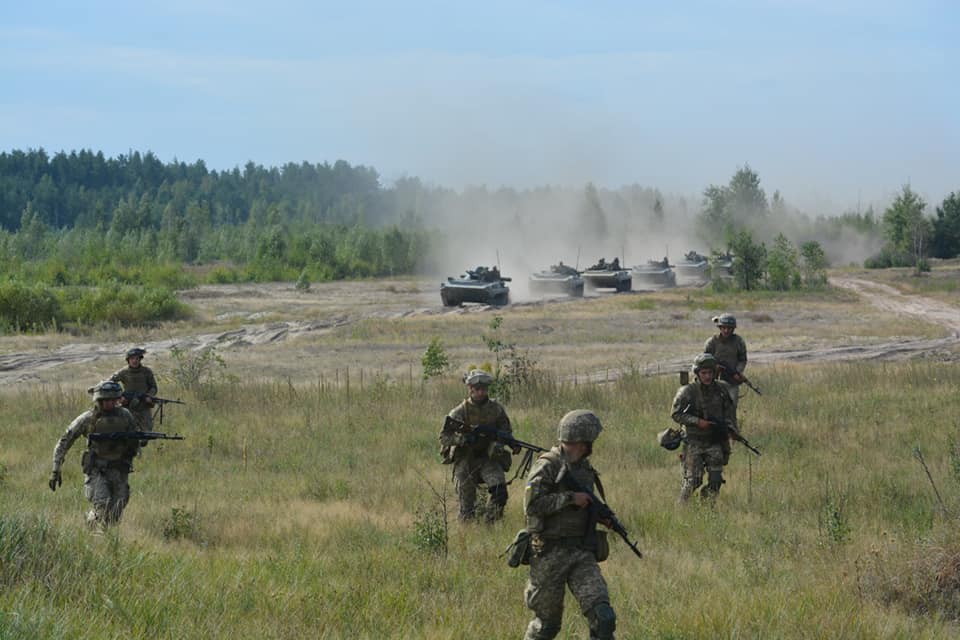Forget steel: Ukraine’s new tank armor is rubber and spikes

A bulky, lumbering Russian vehicle that recently appeared along the 1,100-km front line of Russia’s 42-month wider war on Ukraine boasts the qualities of Russia’s “turtle tanks” as well as the qualities of its more recent “porcupine tanks.” That is: layers of shell-like metal sheeting and, atop that, metal quills that project outward.
The quills help to detonate incoming first-person-view drones before they strike the tank itself. The plating blunts the impact of any drones that get through.
As ugly and ungainly as the hybrid turtle-porcupine tank is, it might actually work under the right circumstances. Examples abound of up-armored vehicles absorbing dozens or even scores of FPVs, which normally weigh just a few pounds and lack explosive power.
If there’s a downside to all this add-on armor, it’s that it almost certainly impedes the vehicle’s mobility by heaping weight onto its original 40- or 50-ton chassis. The extra protection surely also obstructs the driver’s visibility—and probably makes it extremely difficult for the three crew and any infantry passengers to climb onto and off of the vehicle.

This dismount speed can be a matter of life and death when an up-armored tank comes under attack—and any passengers need to get off the vehicle and spread out.
One Russian “porcupine tank”—one of two involved in an assault on Ukrainian defenses outside the ruins of Toretsk, in eastern Ukraine’s Donetsk Oblast, on or before 9 July—survived more than 70 drone strikes before finally succumbing. “It was very difficult to find a weak spot,” the Ukrainian Deep State analysis group noted.
And yes, the infantry riding on that tank and other vehicles struggled to dismount as Ukrainian drones rained down. “After several hits, the tanks tried to disperse along the forest belts to safely land the infantry among the greenery,” the Ukrainian army’s 28th Mechanized Brigade reported. “In the end, there was almost no one to land. And those who still managed to escape … were eliminated.”

The rubber Stryker
Ukrainian forces have deployed their own super-armored vehicles, albeit with a different armor mix. Open-source analyst Andrew Perpetua recently noted the latest example of a drone-proof Ukrainian vehicle—potentially an American-made Stryker wheeled fighting vehicle.
“There was a Russian video attacking a Ukrainian Stryker that Ukraine turned into an invincible tank,” Perpetua observed. “This Stryker ate every single … drone Russia sent at it without even taking a scratch.”
“The armor plan was this,” Perpetua added. “You take a Stryker with the slat armor on top. On top of the slat armor you apply a thick layer of rubber. All over. Whole vehicle is now rubber. Then, take slat armor and put that over the rubber.”
“It went: Stryker, slat, rubber, slat.”
The downside, as always, is all the extra weight on top of the 19-ton basic vehicle. “This had to be the heaviest … Stryker to ever stryke,” Perpetua quipped.
To be clear, the base vehicle may not have been an 11-person Stryker, Perpetua conceded. It may have been a Soviet-style BTR weighing 18 tons and accommodating 10. In any event, “that little porker probably weighs as much as a [69-ton, four-person M-1] Abrams [tank]. But it ate drones like no tomorrow.”
Of course, add-on armor is no panacea. Yes, the most heavily up-armored vehicles stand a decent chance of surviving a few—or even a lot—of drone strikes. Most vehicles remain extremely vulnerable not just to drones, but to all the myriad dangers along the front line. Mines. Artillery. Missiles.
It’s not for no reason that the Russians have parked most of their surviving vehicles—and now mostly attack on foot or on motorcycles. Under the cover of drones, of course. Meanwhile, the Ukrainians usually defend with infantry sheltering in trenches. Also under the cover of drones.

Thanks to your incredible support, we’ve raised 70% of our funding goal to launch a platform connecting Ukraine’s defense tech with the world – David vs. Goliath defense blog. It will support Ukrainian engineers who are creating innovative battlefield solutions and we are inviting you to join us on the journey.
Our platform will showcase the Ukrainian defense tech underdogs who are Ukraine’s hope to win in the war against Russia, giving them the much-needed visibility to connect them with crucial expertise, funding, and international support.
We’re one final push away from making this platform a reality.

